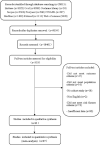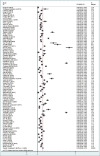Prevalence and associated factors of mortality after percutaneous coronary intervention for adult patients with ST-elevation myocardial infarction: A systematic review and meta-analysis
- PMID: 37064794
- PMCID: PMC10098139
- DOI: 10.4103/jrms.jrms_781_21
Prevalence and associated factors of mortality after percutaneous coronary intervention for adult patients with ST-elevation myocardial infarction: A systematic review and meta-analysis
Abstract
Background: There is a paucity of systematic reviews on the associated factors of mortality among ST-elevation myocardial infarction (STEMI) patients after percutaneous coronary intervention (PCI). This meta-analysis was designed to synthesize available evidence on the prevalence and associated factors of mortality after PCI for adult patients with STEMI.
Materials and methods: Databases including the Cochrane Library, PubMed, Web of Science, Embase, Ovid, Scopus, ProQuest, MEDLINE, and CINAHL Complete were searched systematically to identify relevant articles published from January 2008 to March 2020 on factors affecting mortality after PCI in STEMI patients. Meta-analysis was conducted using Stata 12.0 software package.
Results: Our search yielded 91 cohort studies involving a total of 199, 339 participants. The pooled mortality rate for STEMI patients after PCI was 10%. After controlling for grouping criteria or follow-up time, the following 17 risk factors were significantly associated with mortality for STEMI patients after PCI: advanced age (odds ratio [OR] = 3.89), female (OR = 2.01), out-of-hospital cardiac arrest (OR = 5.55), cardiogenic shock (OR = 4.83), renal dysfunction (OR = 3.50), admission anemia (OR = 3.28), hyperuricemia (OR = 2.71), elevated blood glucose level (OR = 2.00), diabetes mellitus (OR = 1.8), chronic total occlusion (OR = 2.56), Q wave (OR = 2.18), without prodromal angina (OR = 2.12), delay in door-to-balloon time (OR = 1.72), delay in symptom onset-to-balloon time (OR = 1.43), anterior infarction (OR = 1.66), ST-segment resolution (OR = 1.40), and delay in symptom onset-to-door time (OR = 1.29).
Conclusion: The pooled prevalence of mortality after PCI for STEMI patients was 10%, and 17 risk factors were significantly associated with mortality for STEMI patients after PCI.
Keywords: Meta-analysis; ST-elevation myocardial infarction; mortality; percutaneous coronary intervention.
Copyright: © 2023 Journal of Research in Medical Sciences.
Conflict of interest statement
There are no conflicts of interest.
Figures




References
-
- Tanik VO, Cinar T, Arugaslan E, Karabag Y, Hayiroglu MI, Cagdas M, et al. The predictive value of PRECISE-DAPT score for in-hospital mortality in patients with st-elevation myocardial infarction undergoing primary percutaneous coronary intervention. Angiology. 2019;70:440–7. - PubMed
-
- Zijlstra F, Hoorntje JC, de Boer MJ, Reiffers S, Miedema K, Ottervanger JP, et al. Long-term benefit of primary angioplasty as compared with thrombolytic therapy for acute myocardial infarction. N Engl J Med. 1999;341:1413–9. - PubMed
Publication types
LinkOut - more resources
Full Text Sources
Miscellaneous
